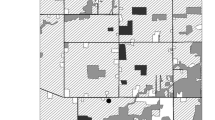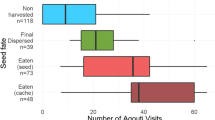Abstract.
We studied two species of Ceratogymna hornbills, the black-casqued hornbill, C. atrata, and the white-thighed hornbill, C. cylindricus, in the tropical forests of Cameroon, to understand their movement patterns and evaluate their effectiveness as seed dispersers. To estimate hornbill contribution to a particular tree species' seed shadow we combined data from movements, determined by radio-tracking, with data from seed passage trials. For 13 individuals tracked over 12 months, home range varied between 925 and 4,472 ha, a much larger area than reported for other African avian frugivores. Seed passage times ranged from 51 to 765 min, with C. atrata showing longer passage times than C. cylindricus, and larger seeds having longer gut retention times than smaller seeds. Combining these data, we estimated that seed shadows were extensive for the eight tree species examined, with approximately 80% of seeds moved more than 500 m from the parent plant. Maximum estimated dispersal distances for larger seeds were 6,919 and 3,558 m for C. atrata and C. cylindricus, respectively. The extent of hornbill seed shadows suggests that their influence in determining forest structure will likely increase as other larger mammalian dispersers are exterminated.
Similar content being viewed by others
Author information
Authors and Affiliations
Additional information
Electronic Publication
Rights and permissions
About this article
Cite this article
Holbrook, K., Smith, T. Seed dispersal and movement patterns in two species of Ceratogymna hornbills in a West African tropical lowland forest. Oecologia 125, 249–257 (2000). https://doi.org/10.1007/s004420000445
Received:
Accepted:
Published:
Issue Date:
DOI: https://doi.org/10.1007/s004420000445




